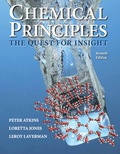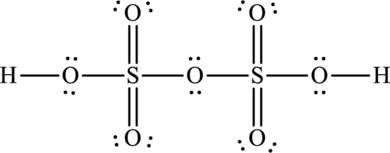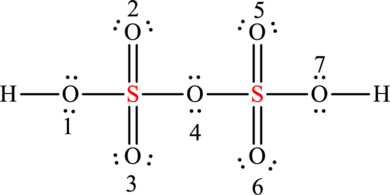
Concept explainers
(a)
Interpretation:
The Lewis structure of oleum has to be drawn.
Concept Introduction:
Lewis Structure: A Lewis structure shows a covalent bond as pair of electrons shared between two atoms.
Procedure to write Lewis formulas:
- 1) The symbols of the atoms that are bonded together in the molecule next to one another are arranged.
- 2) The total number of valence electrons in the molecule is calculated by adding the number of valence electrons for all the atoms in the molecules. If the species is an ion, then the charge of ion into account by adding electrons, if it is a negative ion or subtracting electrons if it is a positive ion.
- 3) A two-electron covalent bond is represented by placing a line between the atoms, which are assumed to be bonded to each other.
- 4) The remaining valence electrons as lone pairs about each atom are arranged so that the octet rule is satisfied for each other.
(a)
Answer to Problem 8H.8E
The Lewis structure of oleum is,

Explanation of Solution
Oleum is otherwise known as pyrosulphuric acid and its formula is
The number of valence electrons in hydrogen=
The number of valence electrons in oxygen=
The number of valence electrons in sulphur=
The total number of valence electrons in oleum is fifty-six.
The Lewis structure of oleum is,

(b)
Interpretation:
The formal charge on sulphur and oxygen in oleum has to be determined.
Concept Introduction:
Formal charge (F.C): The charges that assigned to each atom in a molecule or ion by a set of arbitrary rules and don not actually represent the actual charges on the atoms are called as formal charges.
The formal charge is calculated using the formula,
The Lewis structure with zero formal charge or least separated formal charges is the preferred structure of the molecule.
(b)
Answer to Problem 8H.8E
The formal charge in sulphur is zero.
The formal charge in oxygen is zero.
Explanation of Solution
Oleum is otherwise known as pyrosulphuric acid and its formula is
The number of valence electrons in hydrogen=
The number of valence electrons in oxygen=
The number of valence electrons in sulphur=
The total number of valence electrons in oleum is fifty-six.
The Lewis structure of oleum is,

The formal charges on sulphur is,
The formal charge in sulphur is zero.
The formal charges on oxygen
The formal charge on oxygen
The formal charge on oxygen
The formal charge on oxygen
(c)
Interpretation:
The oxidation number of sulphur in oleum has to be drawn.
(c)
Answer to Problem 8H.8E
The oxidation number of sulphur in oleum is
Explanation of Solution
Oleum is otherwise known as pyrosulphuric acid and its formula is
The oxidation number of sulphur in
Want to see more full solutions like this?
Chapter 8 Solutions
EBK CHEMICAL PRINCIPLES
- Compounds such as NaBH4, Al(BH4)3, and LiAlH4 are complex hydrides used as reducing agents in many syntheses. (a) Give the oxidation state of each element in these compounds. (b) Write a Lewis structure for the polyatomic anion in NaBH4, and predict its shape.arrow_forwardDraw Lewis structures for these ions and show which atom in each bears the formal charge. Q.) H3O+arrow_forwardprovide the following information including the lewis structure and the 3D sketch for PCl4+ and SiH4arrow_forward
- Aluminum oxide (Al₂ O₃) is a widely used industrial abrasive(emery, corundum), for which the specific application depends onthe hardness of the crystal. What does this hardness imply about the magnitude of the lattice energy? Would you have predictedfrom the chemical formula that Al₂ O₃ is hard? Explain.arrow_forwarda. If A represents a group 5A element, what is the formal charge of A in the structure above? b. What is the shape of this molecule? c. Is this a polar molecule?arrow_forwardDraw the Lewis structures for the phosphorus halides PCl3 and PCl5 . Describe their VSEPR shape.arrow_forward
- If the electronegativity of the elements is 1.8 and 4.0 eV, respectively, what is the ionic resonance energy between these two elements in kg / mol?arrow_forwardDraw the Lewis structures of cyanate (OCN-) and fulminate (CNO-) ions and calculate their formal charges. Discuss their stability by giving resonance structures.arrow_forwardWhy does the ionization enthalpy gradually decreases in a group?arrow_forward
- If an element is bonded to 4 other atoms and has a formal charge of +1, what group must the element be in? I know that group 3A atoms are elctron deficient, and that period 3 elements and below, except for group 3A elements like Aluminum, can expand their octet because of their available d-orbital, which may not be relevant to this problem. I don't understand this question, or why the answer would be 5A. Is it because 5A have odd valence electrons, and can form free radicals, like NO?arrow_forwardDraw the Lewis structure of the azide ion, N3, and calculate the formal charge on each nitrogen atom in the structure:arrow_forwardWhat is the VSEPR geometrical shape of the silicate ion, SiO32- ?arrow_forward
 Chemistry: The Molecular ScienceChemistryISBN:9781285199047Author:John W. Moore, Conrad L. StanitskiPublisher:Cengage Learning
Chemistry: The Molecular ScienceChemistryISBN:9781285199047Author:John W. Moore, Conrad L. StanitskiPublisher:Cengage Learning Chemistry: Principles and PracticeChemistryISBN:9780534420123Author:Daniel L. Reger, Scott R. Goode, David W. Ball, Edward MercerPublisher:Cengage Learning
Chemistry: Principles and PracticeChemistryISBN:9780534420123Author:Daniel L. Reger, Scott R. Goode, David W. Ball, Edward MercerPublisher:Cengage Learning

